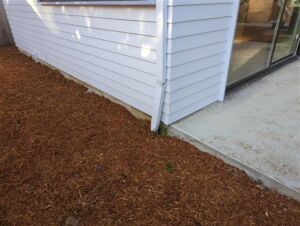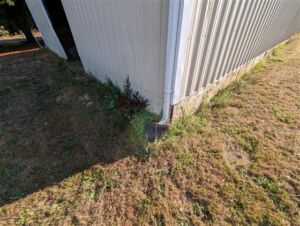
The foundation of the home is crucial because it is responsible for supporting the entire structure and distributing its weight effectively. However, when downspouts direct roof runoff towards the foundation, excess water accumulates at the base, posing a serious threat. Over time, this accumulation can cause erosion and compromise the foundation’s structural integrity. The continuous water (hydrostatic) pressure and moisture weaken the foundation, potentially leading to cracks and settling. Repairing foundation damage requires substantial cost and effort; thus, it is vital to prioritize prevention.
Allowing downspouts to drain at the foundation not only increases the risk of water infiltration into basements or crawl spaces but also poses a threat to the overall health and well-being of residents. Dampness, mold growth, and decreased air quality are common consequences of having water intrusion into the basement and crawlspace.. The presence of mold can deteriorate indoor environments and is particularly hazardous for individuals with respiratory issues or allergies.
Considering these risks, it is critical to divert all roof surface runoff away from the home. One preventive measure involves installing a proper drainage system to guide water away from the foundation.

Another effective solution is to extend downspouts to safely discharge water at least 6 feet from the home. By utilizing downspout extensions that direct water towards well-drained areas, significant reduction in potential hazards caused by inadequate drainage can be achieved.
Diverting roof surface runoff away from the foundation is much more important than people often realize. It serves as an investment in the long-term durability and stability of the home. Furthermore, by embracing responsible water management and drainage solutions, homeowners play a vital role in environmental conservation through reduction in soil erosion and prevention of unnecessary water wastage.
Regular inspections and maintenance play a crucial role in homeowners’ routines, ensuring that the drainage system, downspouts, and extensions function optimally. This proactive approach effectively diverts water away from the foundation and safeguards the home against potential risks.
In conclusion, allowing downspouts to drain at the foundation poses extensive and far-reaching risks. It is crucial for every homeowner to prioritize diverting roof surface runoff safely away from the house in order to protect their investment and the well-being of their loved ones. Responsible water management is a fundamental aspect of homeownership, and smart homeowners should make preventing potential damage a top priority. By diligently implementing these practices, individuals can preserve their homes, ensure family safety, and contribute to a more sustainable and resilient living environment.
